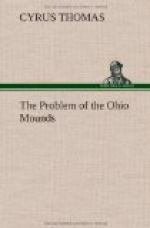The chief hostile pressure against them of which we have any knowledge was from the Iroquois of the north. This testimony is further strengthened by the linguistic evidence, as it has been ascertained that the language of this tribe belongs to the Iroquoian stock. Mr. Horatio Hale, a competent authority on this subject, in an article on Indian migrations published in the American Antiquarian, [Footnote: Am. Antiquarian, vol. 5, 1883, p. 26] remarks as follows:
Following the same course of migration from the northeast to the southwest, which leads us from the Hurons of eastern Canada to the Tuscaroras of central North Carolina, we come to the Cherokees of northern Alabama and Georgia. A connection between their language and that of the Iroquois has long been suspected. Gallatin, in his “Synopsis of Indian Languages,” remarks on this subject: “Dr. Barton thought that the Cherokee language belonged to the Iroquois family, and on this point I am inclined to be of the same opinion. The affinities are few and remote, but there is a similarity in the general termination of the syllables, in the pronunciation and accent, which has struck some of the native Cherokees.”
The difficulty arising from this lack of knowledge is now removed, and with it all uncertainty disappears. The similarity of the two tongues, apparent enough in many of their words, is most strikingly shown, as might be expected, in their grammatical structure, and especially in the affixed pronouns, which in both languages play so important a part.
More complete vocabularies of the Cherokee language than have hitherto been accessible have recently come into possession of the Bureau of Ethnology, and their study serves to confirm the above conclusion that the Cherokees are an offshoot of Iroquoian stock.
On the other hand, the testimony of the mounds all taken together or considered generally (if the conclusion that the Cherokees were the authors of the North Carolina and East Tennessee mounds be accepted) seems to isolate them from all other mound-building people of that portion of the United States east of the Rocky Mountains. Nevertheless there are certain remains of art which indicate an intimate relation with the authors of the stone graves, as the engraved shells, while there are others which lead to the opinion that there was a more intimate relation with the mound-builders of Ohio, especially of the Scioto Valley. One of these is furnished by the stone pipes so common in the Ohio mounds, the manufacture of which appears also to have been a favorite pursuit of the Cherokees in both ancient and modern times.




